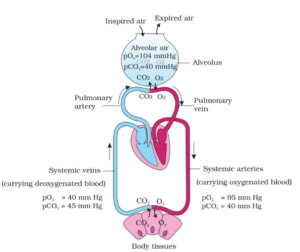Breathing and Exchange of Gases MCQ/Objective questions Chapter 17 Biology
Exchange of gases in earthworm takes place through
- a. Cuticle
- b. Tracheal tubules
- c. Gills
- d. Lungs
Coelontrates, sponges, flatworms and other lower vertebrates exchange gases through
- a. Cuticle
- b. Tracheal tubules
- c. Gills
- d. Body surface
Which organ aquatic arthropuds and molluscs use to exchange gases?
- a. Cuticle
- b. Tracheal tubules
- c. Gills
- d. Body surface
A surfactant that prevents collapsing of alveoli is
- a. Pectin
- b. Lecithin
- c. Cellulose
- d. None
‘c’ shaped ring that prevent collapse of tracea is made up of
- a. Elastic cartilage
- b. Hyaline cartilage
- c. Fibrous cartilage
- d. None
Air passes into trachea from pharynx via
- a. Mouth
- b. Larynx
- c. Epiglottis
- d. None
Cartilaginous box which helps in sound production is
- a. Mouth
- b. Lung
- c. Pharynx
- d. Larynx
Thin sac like vascularised structure present in the lungs is
- a. Tracheole
- b. Branchiole
- c. Alveoli
- d. trachea
Lung is surrounded by pleural membrane which contains:
- a. Water
- b. Pleural fluid
- c. Air
- d. None
Cardiac notch is present in
- a. Right lung
- b. Left lung
- c. Both lungs
- d. None
Which tissue makes the alevoli of lungs?
- a. Simple squamous
- b. Simple cuboidal
- c. Simple columnar
- d. None
The amount that we breathe in or breath out during natural breathing is
- a. Expiratory Reserve Volume (ERV)
- b. Inspiratory Reserve Volume (IRV)
- c. Tidal Volume (TV)
- d. Vital capacity (VC)
Volume remain in the lungs after forceful expiration is:
- a. TV
- b. VC
- c. Reserve volume (RV)
- d. Function Residual Capacity (FRC)
Total lung capacity is
- a. Vital capacity + Reserve capacity
- b. Vital capacity – Reserve capacity
- c. Tidal volume + Reserve volume + Inspiratory reserve volume
- d. None
The only vein that carry oxygenated blood is
- a. Renal vein
- b. Hepatic vein
- c. Pulmonary vein
- d. None
The only artery that carries impure/deoxygenated blood is:
- a. Renal artery
- b. Sinusoidal artery
- c. Pulmonary artery
- d. None


- a. CO2
- b. O2
- c. CO
- d. All three
Respiratory rhythem centre in brain which regulate rate of respiration is a part of:
- a. Cerebrum
- b. Cerebellum
- c. Medulla oblongata
- d. None
A region in pons which regulate respiratory rhythemcentre is
- a. Chemotriggerzone
- b. Pneumotaxis center
- c. Hypothalamus
- d. None
Promininet cause of emphysema is
- a. Malnutrition
- b. Poor hygiene
- c. Cigarette smoking
- d. Adverse drug reaction
Read also:
Plant Growth and Development MCQ
Photosynthesis in Higher Plants MCQ
Breathing and Exchange of Gases MCQ/Objective questions Chapter 16 Biology
Ref: Chapter 17.
thanks!